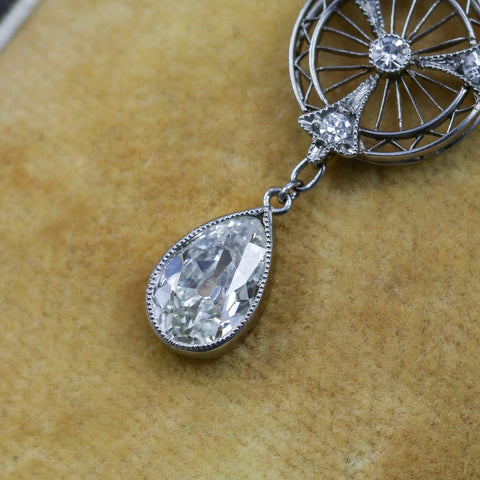
Pear Shape
History’s First Pear Shape Diamonds
It was long known that diamonds were the hardest substance known to man, even the Ancient Greeks used the word “adámas”, meaning “unbreakable”. It wasn’t until the mid to late 15th century when a Flemish jeweler and diamond cutter by the name of Lodewyk van Bercken allegedly used this knowledge to creatively change the industry.
As we discussed previously in the Table cut article, there is a solid argument that Lodewyk van Bercken never existed, and no indication that he contributed as much to the world of lapidary as his descendent, Robert de Berquen (1615-1672) claimed.
The first mention in history of a pear shape diamond is a bit hidden, as at the time, it was referred to as a heart shape. This occurred during a documented exchange between Duke of Milan, Galeazzo Maria Sforza and the Duke’s confidante Nicodemo. Sforza wrote to Nicodemo describing Florentine banker and politician Cosimo de Medici, “He commands a Titus Livy just as you might a heart-shaped diamond.”
Referenced by Jack Ogden, there is another example documented in a list of jewels sent to King Henry VIII in 1514 in which one of the diamonds is described as “a harte [heart] of dyamant, rising full of lozenges”. The heart reference is most likely refering to a pear shape, and the “lozenges” mentioned are a description of additional facets in the stone.
The Modern Pear Shape Diamond
Like a marquise cut, oval cut, emerald cut or radiant cut, the length of a pear shape diamond can accentuate the length of the wearer's finger. Even for those who don’t have long, slim fingers, a lengthy stone will create the appearance of elongated fingers. The pear shape is most commonly worn with the point facing out (going up the finger), but current trends have seen people wearing these stones with the stone facing towards them, or even set east to west or diagonally on a finger.
The modern pear shape diamond is cut in the brilliant style with 58 carefully placed facets. The pear shape is one of the more complicated cuts to shape, leading to a lot of pear shape diamonds, which look slightly different from one another. Some are longer, some are chunkier. At the end of the day, the stone you like best is what is most important, but as a general rule, the “ideal” length to width ratio for a pear shape diamond should be 1.5:1.
Famous Pear Shape Diamonds Throughout History
Over time, the pear shape diamond continued to maintain it’s popularity, although never taking the center stage as the most popular cut out there. Some famous pear shape diamonds throughout history include the Arcot diamonds (owned by Queen Charlotte), the fancy pink Conde diamond (owned by King Louis XIII of France), the famous Cullinan I diamond (currently set in the English Imperial State Crown), the fancy blue Tereschenko Diamond, the 41ct Dresden Green Diamond as well as other important modern stones such as the Taylor Burton Diamond, the 14.82ct diamond known as “The Orange Diamond” (the only fancy vivid orange diamond in the world over 10 carats), the 100.10 carat D color, Internally Flawless Star of the Season Diamond, the 137.02ct Premier Rose Diamond, and the 203.04 carat D Color, Flawless Millennium Star Diamond (the second largest “D” color diamond in existence).
Current celebrities who wear a pear shape diamond as their engagement ring include Victoria Beckham, Cardi B, Margot Robbie, Emily Ratajkowski, Kaley Cuoco, Sophie Turner, Anna Kournikova, and Princess Charlene of Monaco.

 An Antique Pear Cut Diamond Dangling From an Art Deco Necklace
An Antique Pear Cut Diamond Dangling From an Art Deco Necklace Pear Shape Diamonds with Wide, Ideal and Skinny Proportions
Pear Shape Diamonds with Wide, Ideal and Skinny Proportions